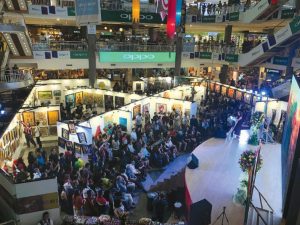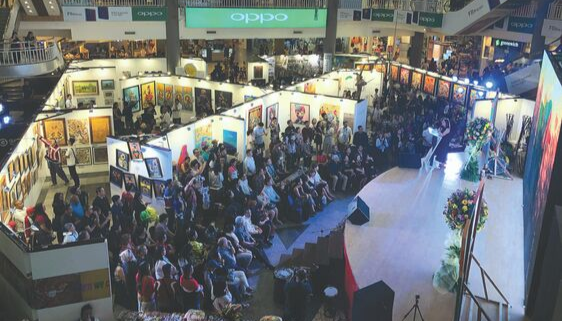
DAVAO CITY (MindaNews) — Waters. What would Mindanao be without its waters especially the sea that surrounds the main island and its islets, the lakes (from where the name Mindanao comes from as danao or ranao or lanao refer to this body of water) and its mighty rivers that flow from watersheds in the uplands towards the cities of Butuan, Cagayan de Oro, Davao, Pagadian and Cotabato.
But rivers – apart from being bodies of water that serve nature and humanity in myriad ways – are powerful metaphorical images that help us conjure historical journeys as well as evoke memories that help define the interiority of our identity as a people with our own distinct cultural legacies.
Comes now the First Mindanao Art Fair, Exhibit and Conferences (MAFEC or as it is referred to now, MindanaoArt). It had a grand opening at the Atrium of Gaisano Mall, Davao City on Friday, October 4. The exhibit runs for two days on October 5-6, with a conference on Saturday – Mindanao Art Talk – at the Philippine Women’s College. This event is centered on the theme – “Traversing the River of Creative Generations” as it “recognizes the role of the rivers abundant in the Davao region in the flourishing of life and development.”
As soon as one enters the exhibit space, one reads journalist-artist Stella Estremera’s text on the exhibit’s theme relating rivers to the world of art that embraces the whole physical, historical, ethnographic richness of Mindanao. As the viewer walks further down the corridor, one is confronted with “The Silent Witness” a two-panel mural done in oil that serves as the central piece of the exhibit highlighting its theme. This is an awesome art work produced by an art collective known as Piguras Davao composed of Dominic Turno, Alfred Galvez, Rey Bollozos, Rene Pilapil, Dominic Pilapil, Bryan Cabrera, Kim Vale, Mark Tolentino, King Nelson Duyan, and Raymund Ric Bisnar.
As meticulously explained by anthropologist Vinci Bueza of the Ateneo de Davao University, this panel “measuring 6 feet by 20 feet each, takes its inspiration from the rich history of Davao, including indigenous mythologies, popular culture, and surreal symbolisms.”
If the Davao City government is serious about putting up a grand museum inside People’s Park, they should already make sure to acquire the rights of the two-panel work so it can find a pride of place in the museum’s gallery. That would be a great way to pay homage to our local artists and make sure the generations to come have a glimpse into the uniqueness of Mindanao visual art.
Conceptualized about three years ago by Kublai Millan – Davao’s distinguished sculptor-painter, Stella Estremera and their visual artists’ group known as Lawig-Diwa, this event was meant “to pave the way in building a sustainable art industry for talented creators in the region… as well as to provide avenues to Mindanawon artists, both established and emerging, to display their works to reach and inspire diverse audiences of all ages and make Mindanao artists be recognized further into the burgeoning Philippine art scene.”
As one enters the exhibit space, one gets to see a poster of photos of the art conference speakers — Vim Nadera, Elba Cruz, Gerry Leonardo, Cid Reyes, Leeroy New, Dominic Rubio, Rosalie Zerrudo, Riel Hilario, Pope Dalisay, Jack Teotico and Melissa Yeung-Yap.
MindanaoArt is certainly a major breakthrough for Mindanawon artists. While there have been previous attempts to bring together our local artists at various exhibits, MindanaoArt is unique as it provides a venue for Mindanawon artists’ works to interface with their counterparts from other parts of the country, while also providing a forum to discourse on the state of Philippine/Mindanawon visual art as well as build artists’ networks for mutual inspiration, encouragement and support. One can only hope that in the coming years, there will be a second and third MindanaoArt despite the fact that organizing such a momentous event requires so much time, effort, financial resources and human labor and expertise.
To view the more than a hundred art pieces representing the various visual art forms – from sculptures to paintings, photographs to art installations – one needs a full day to fully appreciate the richness of the collection put together by Lawig-Diwa and those who helped curate this exhibit.
Depending on the viewers’ world view, exposure to the whole range of art forms, interests in the field of visual arts, what they desire as collectors as well as their political stance, there are works in the exhibit that they would be attracted to. Some are much more visually attractive than others, there are those that are the quintessential art profiling the Moro and Lumad realities, in some cases social realism interfaces with the surreal, a cluster tapping into the rich colors of the earth and a few attempts at making political statements. A friend noted that MindanaoArt involved the works of at least 67 Mindanawon artists, 38 from Davao and 29 from Butuan, Zamboanga, Bukidnon and Cagayan de Oro.
Another cluster that is most striking is the collection of the Talaandig Lumad artists. Using soil as their medium, they have developed an artistic technology tapping into the hues of the earth for their paintings which encompass themes of their mythologies, indigenous beliefs, cultural legacies and discourses on Lumad cultural erosions and ecological degradation.
There is also the cluster that is perhaps the only one that has a strong political comment on Mindanao realities today. Conceptualized and executed by Cagayan de Oro artists Nic Aca and Froilan Gallardo, this cluster is made up of blown-up photos of the Marawi Seige (by Gallardo), wood intermedia works and a video art performance (by Aca). Froilan’s huge photo is most striking as it combines bright colors emerging out of a war-torn locale, capturing the contradictions arising out of armed conflict. Aca’s filmed art performance (mounted at an art exhibit in Bangladesh) is a ten-minute performance that can break one’s heart. His wood intermedia work titled “Change” is perhaps the strongest political message in this whole collection.
Feminists would easily flock to Rosalie Zerrudo’s corner with three art installations made up of embroidered images of the vagina done by women prisoners in an Iloilo jail, most of whom are incarcerated for various crimes, especially related to drugs. While one easily thinks this is inspired by The Vagina Monologues, the three pieces in this exhibit have their own unique representations. One has to see these to appreciate the work that have been exerted to come up with the art work. While seemingly whimsical and capricious with the use of bright colors and erotic images, a viewer can also discern the fury behind those embroidered pieces put together by Zerrudo as a statement to champion women’s concerns in a still misogynistic society.
There is a cluster from Zamboanga; Kiko Miranda’s black-and-white works combining fishes and eyes are most striking.
The sculptors are also a sight to see, combing pieces constituted by different materials (from wood to metal, driftwood to cement, stonecast resin reinforced by fibreglass to glass), content (from Lumad mythologies e..g. the ever present Mebuyan to nature studies) and styles (from realistic to surreal).
There is even a sculpture-cum-art installation done by Noi Narciso who fashioned a musical instrument from all kinds of junk. Kids – and even adults who are young-at-heart – can easily be fascinated with this art serving as a unique musical instrument.
But of course the local masters of Davao who are now making waves in the art scene with collectors beginning to acquire their pieces – the likes of Kublai Milan, Anoy Catague, Madeline dela Rosa, Ronald Gaspe, Roland Delara, Waway Saway and his nephew R.J. Sumingsang, Mark Tolentino. Victor Secuya and the various painters’ groups working as collective.
Part of MindanaoArt’s goal is “to build an industry so that the artists can now make more art ng hindi nagugutom” (while not being starved) and so MindanaoArt is doing its best to bring in the collectors.”
One can only admire the Lawig-Diwa group for its efforts at organizing MindanaoArt. We salute them and wish them luck for more MindanaoArt productions in the coming years.
However, it will be good for the organizers to listen to the feedback of the viewers who share their passion and would like to see MindanaoArt flourish even further in the years to come.
If MindanaoArt is truly representative of the richness of Mindanawon art, it would do well to have more Lumad and Moro artists participating. In this first one, a Moro art perspective was hardly represented and except for the Talaandigs, same goes to the Lumad. And it is not as if there are no Moro and Lumad artists all across the island.
Perhaps part of what is needed is to expand the network of artists across Mindanao with extra effort to bring in other Lumad artists, e.g. Carlito Camahalan, a Manobo from Agusan who recently exhibited in New York. There are many others like him from among the Lumad communities. There is also need to check out from among the Tausogs, Maguindanao, Maranaws, Iranun, Kagan, Yakan and other Islamized ethnolingustic groups. The fact of the matter is that they are the first Mindanawon artists from way back the pre-conquest years and their art continues to be sustained up to now.
Perhaps what is needed is to expand on the horizon of MindanaoArt to not just privilege lowland recognized artists but expand its range to accommodate what is pejoratively referred to as “folk art” but which are truly art works that have survived through a long period of time despite colonization.
For after all, like the rivers of Mindanao flowing through time, the memories of our Lumad and Moro artists of their artistic legacies continue to flow into what are still produced and reproduced in their communities. And one only needs to view the richness of handwoven textiles to the weapons of the pandays to the brasswork of the musical instruments to be fully convinced that long before migrant settlers and the ensuing migrant stock produced art in Mindanao, our Moro and Lumad ancestors have produced the best of art anchored in the beauty of the earth!
[Redemptorist Brother Karl Gaspar is a professor at St. Alphonsus Theological and Mission Institute (SATMI) in Davao City and a professor of Anthropology at the Ateneo de Davao University. Gaspar is the most prolific Mindanawon book author, having written at least 22 books since 1985, including “Desperately Seeking God’s Saving Action: Yolanda Survivors’ Hope Beyond Heartbreaking Lamentations,” two books on Davao history, and “Ordinary Lives, Lived Extraordinarily – Mindanawon Profiles” launched in February 2019. He writes two columns for MindaNews, one in English (A Sojourner’s Views) and the other in Binisaya (Panaw-Lantaw)]
By Karl M. Gaspar CSsR

